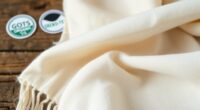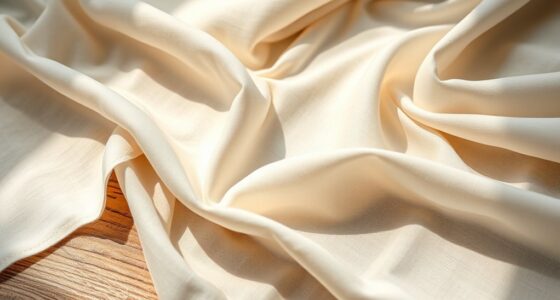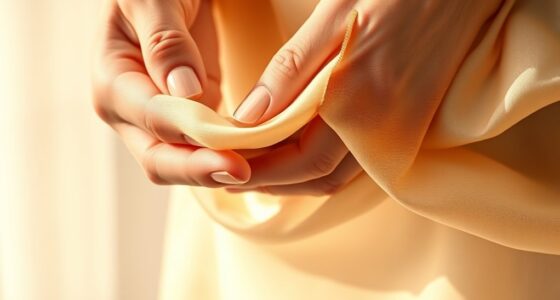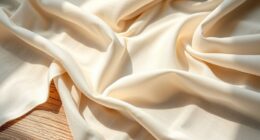To spot quality selvedge denim in 10 seconds, look for the raw edge on the cuff, which shows authentic craftsmanship. Check for a vibrant colored line—red, white, or blue—that runs along the edge. Feel the fabric; it should be dense and tightly woven, indicating durability. The raw edge and colored line are quick visual cues of high-quality, traditional construction. Keep exploring to uncover more secrets behind genuine selvedge denim.
Key Takeaways
- Look for a clean, raw edge at the cuff; genuine selvedge denim always shows this detail.
- Check for a colored line (red, white, or blue) along the selvage for authenticity.
- Tightly woven fabric indicates high-quality construction and durability.
- The raw edge signifies traditional craftsmanship and minimal processing.
- Authentic selvedge denim develops unique fades and character over time.
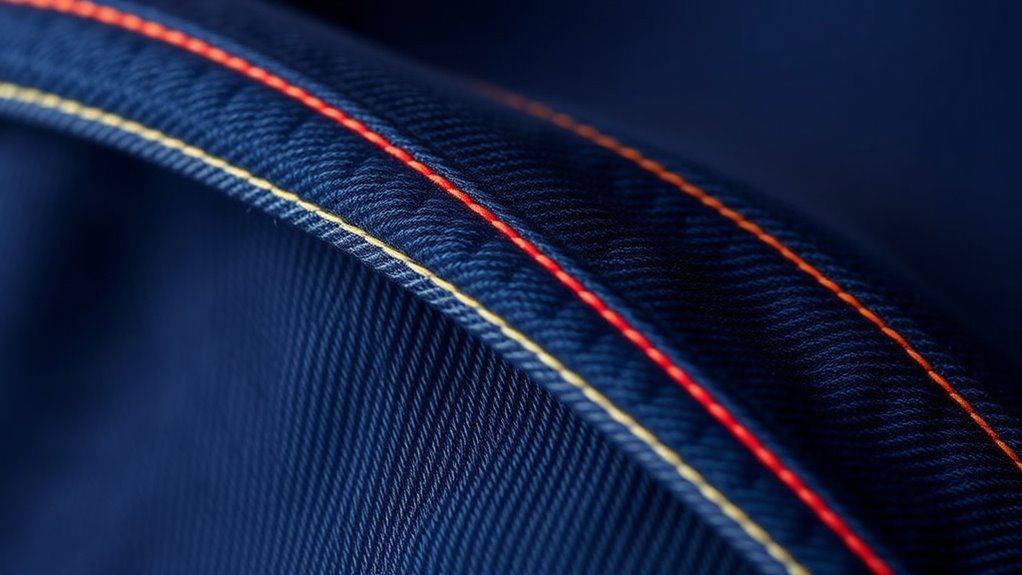
Have you ever wondered what makes selvedge denim stand out from regular denim? The answer lies in its unique construction and finishing touches, which give it a distinctive edge—literally. When you look at selvedge denim, one of the first things you’ll notice is the raw edge, often seen on the cuff of the jeans. This raw edge isn’t just a design feature; it’s a sign that the denim was woven on traditional shuttle looms. These looms produce a narrow, tightly woven band with a clean, finished edge that won’t fray easily. That raw edge is a hallmark of authentic selvedge denim and signals a high-quality product. It’s also a visual cue that the fabric is crafted with care, often resulting in a vintage look that gets better with age. Over time, the denim develops fades and creases that evoke a sense of history and character, making each pair unique.
When you’re inspecting jeans, look closely at the selvedge edge. It’s usually identified by a thin, colored line running along the selvage—common colors are red, white, or blue. This little detail isn’t just decorative; it’s the result of the weaving process on shuttle looms, which produces a dense, durable fabric. Unlike mass-produced denim made on projectile looms, selvedge denim’s tight weave guarantees longevity and a refined appearance. That vintage look you admire is naturally achieved through this process, as the fabric ages beautifully, developing subtle fades and whiskers that give the jeans a worn-in feel from the very first wear.
Choosing selvedge denim means opting for craftsmanship that’s rooted in tradition. The raw edge not only signifies quality but also hints at the durability of the fabric. When you wear these jeans, you’ll notice how they soften and mold to your body over time, enhancing that vintage aesthetic. The raw edge also suggests that the denim hasn’t been over-processed or mass-produced, maintaining its integrity and authenticity. This is what makes selvedge denim a favorite among enthusiasts looking for timeless style and lasting quality. Spotting it in seconds is easy once you know what to look for: the clean, raw edge, the colored line, and the evident craftsmanship. All these details combine to create jeans that stand out for their durability, character, and vintage appeal.
Frequently Asked Questions
How Do I Differentiate Authentic Selvedge Denim From Counterfeit?
To tell authentic selvedge denim from counterfeit, you look at the fabric weave and edge finishing. Authentic selvedge denim features a tight, clean weave that’s usually visible on the selvage edge. The edge finishing should be smooth, with a colored line running along the selvage, indicating quality craftsmanship. If the edge looks frayed or the weave seems loose, it’s likely fake. Always examine the selvage details closely for genuine quality.
What Are the Best Care Tips to Preserve Selvedge Denim Quality?
To preserve your selvedge denim’s quality, focus on proper washing techniques like cold water washes and minimal washing to prevent fading and wear. Always turn your jeans inside out before washing, and avoid harsh detergents. Use suitable storage solutions—fold them neatly and keep them in a cool, dry place to prevent damage. These steps help maintain the denim’s integrity, color, and overall look for years to come.
Can Selvedge Denim Be Repaired if Torn or Damaged?
Did you know that most torn or damaged selvedge denim can be repaired effectively? Yes, repairs and patches can extend your denim’s life, even after significant damage. You can mend small tears with sewing or professional damage mitigation techniques, preserving its look and durability. For larger damage, patching or reinforcing areas works well, keeping your denim wearable and stylish. Proper repairs can make your favorite piece last for years.
Are There Specific Brands Known for Superior Selvedge Quality?
When choosing denim, you might wonder about brands known for superior selvedge quality. Premium brands like Iron Heart, Momotaro, and Samurai focus on exceptional craftsmanship details, ensuring durable, high-quality selvedge denim. These brands often use traditional weaving techniques and premium materials, giving you denim that’s not only stylish but built to last. By selecting from these premium brands, you get the best in craftsmanship, authenticity, and longevity in your selvedge denim.
How Does Selvedge Denim Age and Develop Character Over Time?
As you wear your selvedge denim, you’ll notice it ages beautifully through fiber aging and fade patterns. The fibers subtly break down, creating unique creases and whiskers that tell your story. Over time, the denim develops a rich character, with fades highlighting areas of movement. This natural evolution makes your jeans truly one-of-a-kind, reflecting your lifestyle and giving you a deeply personal connection to your wardrobe.
Conclusion
Now that you know what to look for, spotting quality selvedge denim becomes second nature—like a skilled artist recognizing the brushstrokes of a masterpiece. In just 10 seconds, you can distinguish craftsmanship from mass production, much like finding a rare gem amid ordinary stones. Trust your eye, and soon you’ll be exploring the world of denim with the confidence of a seasoned collector, always uncovering the hidden treasures woven into every inch of authentic selvedge.

